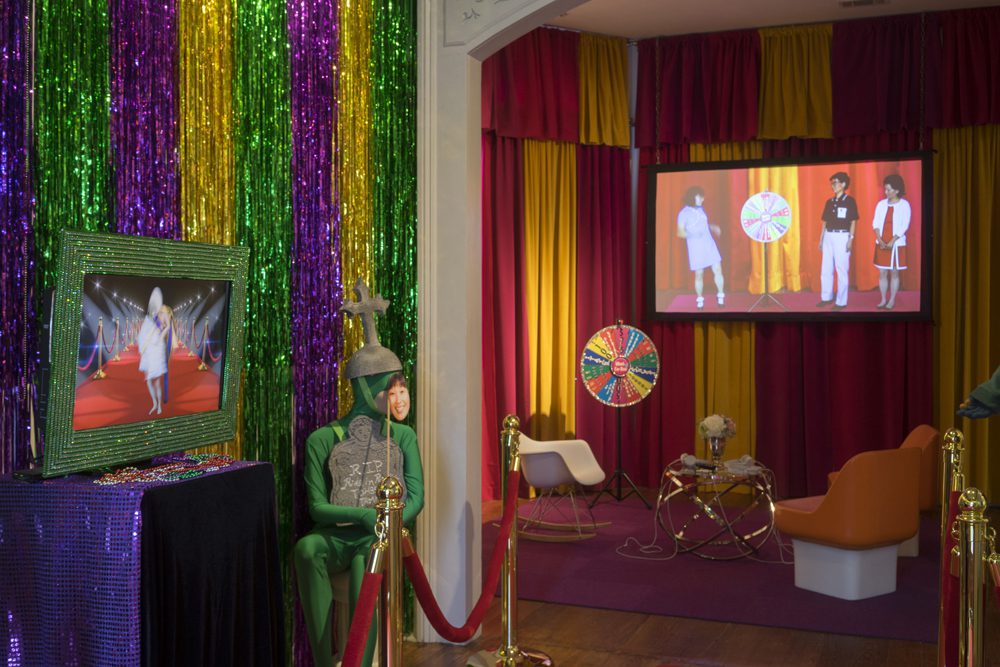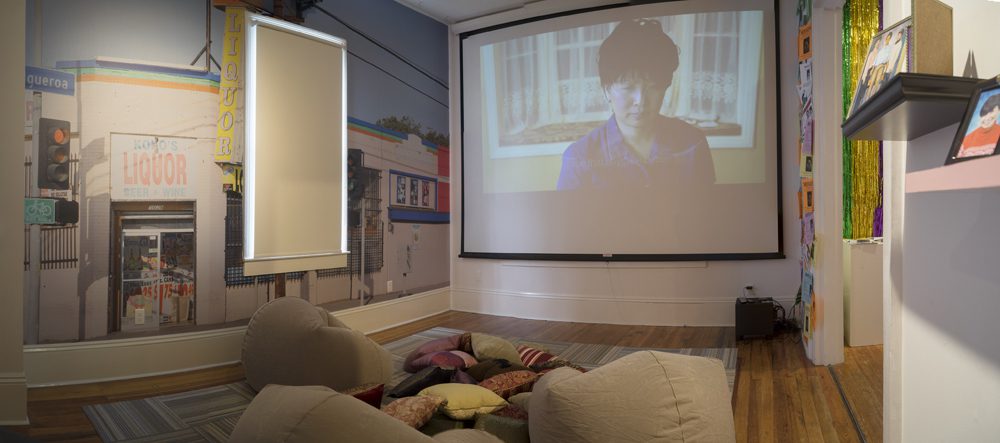Too Much TV: An Interview with Yoshie Sakai
Taylor Murrow talks to Los Angeles-based artist Yoshie Sakai about East Asian soap operas, growing up between cultures, and her recent solo show at Antenna.

Installation view of “KOKO’s Love: A Soap Opera Tale of One Family” at Antenna, New Orleans. Courtesy the artist and Antenna, New Orleans. Photo by Tammy Mercure.
Editor's Note
In KOKO’s Love, the soap-opera-inspired drama created by Los Angeles-based artist Yoshie Sakai, Yuki is the only child in a Japanese-American family living in L.A. Yuki’s father, Hiroshi, is perpetually disappointed in her, having no male heir to take over the liquor store he owns, before young Yuki is kidnapped in the video’s dramatic conclusion.
This July, Sakai premiered the second “episode” of KOKO’s Love in New Orleans at Antenna, bringing the viewer straight into her garish soap-opera world. Each corner of the gallery was colorfully styled to resemble a cut-rate game show or a family home. Video installations throughout told the stories of the main characters, picking up right where episode one left off.
Taylor Murrow: Tell me a little about your installation at Antenna. This included the second episode of KOKO’s Love, correct?
Yoshie Sakai: Yes, finally! I did the first episode in January 2014, so at this rate I’m releasing an episode every two years. It takes me a long time to do one because I play all the roles, plus I do everything from writing the script to putting together costumes to filming. Once I finish one [episode], I’m a little bit tired! This installation is my first solo show since my MFA show in 2008, so it has been really great to be able to see this whole KOKO’s Love thing come together in one space. I really wanted to include New Orleans in this second episode. I came to town in December for ten days, stayed in Antenna’s residency space, walked around, went places, took video, and asked people to help me out with my scenario. At the end of KOKO’s episode one, we see Yuki, the daughter, getting kidnapped in front of the liquor store, so when I came here I would ask people, “So what would you tell a kidnapped, lost seven-year-old in New Orleans?” And so from those interactions, I have some people who have speaking roles [in the episode]. This is my first time having people in it other than myself, but it turned out great. I made some new New Orleans-inspired characters, like an alligator and a beignet. By the way, making that costume was a challenge—How do I make something look like a beignet?!
TM: What’s it like playing every character in your films?
YS: I don’t know—it’s fine, I think. I actually don’t like to perform or act, although people have told me that I’m a good actress. I’m like, “Really? Okay.” I try to get off of the camera as soon as I can. But it is kind of crazy playing every character. I find that the wig really defines you. Whenever you change your wig, you kind of change your character and personality.
TM: I think people down here relate to that. There’s a lot of costuming in this city.
YS: Yes, I actually got a recommendation from someone on opening night for a wig shop. That’s kind of funny that everyone latches on to the wig. You know, the more I think about it, I think playing every character really works out. Because KOKO’s Love is loosely autobiographical. You’re Married...Now What?—that video is pretty true.
TM: True to your parents’ experience?
YS: Yeah, I haven’t shown my mom. She doesn’t like any of my videos that hit close to home. She’s like, “Why do people care? Why do people want to see this?” It is sort of about my culture, being Japanese-American, growing up in Los Angeles, not feeling like I’m a Japanese national—I was born in America—but at the same time, I never really felt like I connected that well with the Japanese-American community either. Because my mom is first-generation, I grew up in a very Japanese home. I was spoken to in Japanese; I can speak Japanese. A lot of the Japanese-American kids don’t speak the language, but they have their own things they do. There’s the sansei sports league—“sansei” means third-generation—and I never participated in that. I always felt kind of caught in between.

Installation view of “KOKO’s Love: A Soap Opera Tale of One Family” at Antenna, New Orleans. Courtesy the artist and Antenna, New Orleans. Photo by Tammy Mercure.
TM: Are you an only child?
YS: Yeah, I am an only child. I think playing all the roles [in my videos] sort of makes sense because it does come down to my life. At first I thought I should get other people to be in my work, but then people told me, “I don’t know, Yoshie. I think it kind of works that it’s all you.”
TM: What I like about the first episode is that it forces the viewer to put herself in those characters in the same way that you do—especially when you have Yuki who dresses like a boy, her father who doesn’t want her, etc. It gives complexity to those characters. How did you come up with the idea for Koko’s Love?
YS: My mom is 82 years old, and she watches a lot of Asian soap operas. A lot of my friends too and me. I watch way more Asian TV than American TV actually, especially these East Asian soaps. Specifically the Japanese ones and Korean ones. But I noticed in the Korean soaps that status is really important, meaning if you’re a poor daughter from a not-so-well-off family and you fall in love with a man who’s maybe a son of the president or of the CEO of a huge company, it’s not allowed. The rich family objects and it’s very much about status. So I thought it would be funny to put a twist on that trope by making this liquor-store owner, who just owns this one liquor store in South Central Los Angeles, not a big company, be the equivalent of this CEO-type character. So that’s where I first came up with that idea, plus my dad actually used to own a liquor store.
TM: So your mom watches a lot of soaps today?
YS: Oh my gosh, that’s all she does. That’s what she lives for. She’s the only one [of her siblings] in America; her one brother and three other sisters all live in Japan. My dad’s second-generation. He grew up on Terminal Island. But my mom—yes, watching soaps is her hobby; it’s her passion.
TM: Well that’s not so far off from the contemporary obsession with American reality-TV shows.
YS: Right, that’s why I feel like the soap genre is really interesting. It’s something that’s very accessible for a lot of people because a lot of people watch reality shows.
TM: And soap operas have been on TV for much longer, decades now.
YS: Oh yeah. My mom still doesn’t really speak English. She came here in 1964, the last time the Olympics were in Tokyo, and she watched General Hospital. She was like, “I don’t really understand English,” but you kind of still understand what’s going on in those types of shows.
TM: Soap-opera drama is a universal language in a way. Everyone is familiar with the tropes, even if you don’t watch them.
YS: Right, and I wanted to use that genre to talk about everyday life. It’s just very accessible; it’s about the everyday. Yasujirō Ozu, do you know him? He was a Japanese filmmaker, but he’s not like [Akira] Kurosawa, with his grand samurai themes. Ozu’s movies are kind of slow, just about the mundane. He had this thing called the tatami point of view in his movies (a tatami is the grass mat typical in a lot of traditional Japanese homes), and he’d shoot from that lower point of view near the ground. It’s a bit weird when you first watch it, but he shoots everything at that level, and all his stories are about everyday things—what happens when family members die, what happens when you don’t get along with your sister, what happens when you wanted to do something else but you just end up supporting the family.

Installation view of “KOKO’s Love: A Soap Opera Tale of One Family” at Antenna, New Orleans. Courtesy the artist and Antenna, New Orleans. Photo by Tammy Mercure.
TM: You play with the idea of celebrity in your work. Did growing up and living so close to Los Angeles have an effect on that at all?
YS: I think it does, greatly. People from Northern California kind of look down on us. There’s this perception that they’re all intellectual and we’re just about Hollywood and that we refer to stars by their first names. I did kind of grow up in that way, and I do get star struck. So it’s funny that you mention that because I do always think that there’s some of that in my work. In this installation, there’s a bit where the characters do a little runway walk on the red carpet, and, yeah, I think it’s all because of my Southern California upbringing. I like making these everyday characters, who are really nobody, somebody, like a celebrity. I’ve never made a documentary but I’ve always thought about making one where regular people become these celebrities, and I’d make t-shirts with their faces on them. I’m surrounded by senior citizens a lot—my mom is older and I’m an only child so I’m usually around older people—and my mom tells me, “Yeah, old people really like you!” I just get along better with seniors, so I’d like to make a documentary about them one day, where seniors are celebrities and people think they’re really cool. But the Southern California thing, living near Hollywood where people are waiting tables and doing whatever they can just because they want to make it, I see it all the time.
Editor's Note
“KOKO’s Love: A Soap Opera Tale of One Family” was on view July 9 – August 7, 2016, at Antenna (3718 St. Claude Avenue) in New Orleans.



